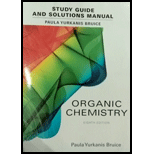
Concept explainers
(a)
Interpretation:
The optically inactive compound for the given molecular formula has to be drawn.
Concept introduction:
Optical activity of a molecule is the interaction between molecule and plane-polarized light.
Molecule having asymmetric center shows optical activity except mesocompounds.
Asymmetric center is a stereocenter which arises to hydrocarbons if the carbon is bonded to four different groups.
Mesocompounds has asymmetric centers and a plane of symmetry, so the molecule superimposable on its mirror image, thereby the compound is achiral.
If the four groups attached to both asymmetric centers of a compound are identical, then the compound is a mesocompound.
(b)
Interpretation:
The mesocompound (optically inactive compound) for the given molecular formula has to be drawn.
Concept introduction:
Optical activity of a molecule is the interaction between molecule and plane-polarized light.
Molecule having asymmetric center shows optical activity except mesocompounds.
Asymmetric center is a stereocenter which arises to hydrocarbons if the carbon is bonded to four different groups.
Mesocompounds has asymmetric centers and a plane of symmetry, so the molecule superimposable on its mirror image, thereby the compound is achiral.
If the four groups attached to both asymmetric centers of a compound are identical, then the compound is a mesocompound.
Asymmetric center is arises to hydrocarbons if the carbon is bonded to four different groups.
(c)
Interpretation:
The optically active compound for the given molecular formula has to be drawn.
Concept introduction:
Optical activity of a molecule is the interaction between molecule and plane-polarized light.
Molecule having asymmetric center shows optical activity except mesocompounds.
Asymmetric center is a stereocenter which arises to hydrocarbons if the carbon is bonded to four different groups.
Mesocompounds has asymmetric centers and a plane of symmetry, so the molecule superimposable on its mirror image, thereby the compound is achiral.
If the four groups attached to both asymmetric centers of a compound is identical, then the compound is a mesocompound.
If a cyclic compound has two asymmetric centers with identical substituents, then cis-isomer of the compound is a mesocompound.
Asymmetric center is arises to hydrocarbons if the carbon is bonded to four different groups.
Want to see the full answer?
Check out a sample textbook solution
Chapter 4 Solutions
Student's Study Guide and Solutions Manual for Organic Chemistry
- Consider the following nucleophilic substitution reaction. The compound listed above the arrow is the solvent for the reaction. If nothing is listed over the arrow, then the nucleophile is also the solvent for the reaction. Part 1 of 2 Br CH,CN + I¯ What is the correct mechanism for the reaction? Select the single best answer. @SN2 ○ SN 1 Part: 1/2 Part 2 of 2 Draw the products for the reaction. Include both the major organic product and the inorganic product. If more than one stereoisomer is possible, draw only one stereoisomer. Include stereochemistry where relevant. Click and drag to start drawing a structure. X હૈarrow_forward20.33 Think-Pair-Share (a) Rank the following dienes and dienophiles in order of increasing reactivity in the Diels-Alder reaction. (i) CO₂Et (ii) COEt || CO₂Et MeO MeO (b) Draw the product that results from the most reactive diene and most reactive dienophile shown in part (a). (c) Draw a depiction of the orbital overlap involved in the pericyclic reaction that oc- curs between the diene and dienophile in part (b). (d) Is the major product formed in part (b) the endo or exo configuration? Explain your reasoning.arrow_forward20.40 The following compound undergoes an intramolecular Diels-Alder reaction to give a tricyclic product. Propose a structural formula for the product. CN heat An intramolecular Diels-Alder adductarrow_forward
- What is the reaction mechanism for this?arrow_forwardWhat is the reaction mechanism for this?arrow_forwardCurved arrows are used to illustrate the flow of electrons. Using the provided starting and product structures, draw the curved electron-pushing arrows for the following reaction or mechanistic step(s). Be sure to account for all bond-breaking and bond-making steps. + Drawing Arrows CH3ONA, CH3OH heat : Br:O Na → H H Br Na + H H H H H :0: .H + Undo Reset Done Q CH3 Drag To Pan +arrow_forward
- What is the reaction mechanism for this?arrow_forward20.19 Predict the structure of the major 1,2-addition product formed by reaction of one mole of Cl₂ with 3-methylenecyclohexene. Also predict the structure of the 1,4-addition product formed under these conditions. 20.20 Which of the two molecules shown do you expect to be the major product formed by 1,2-addition of HCI to cyclopentadiene? Explain. Cyclopentadiene + HC 3-Chlorocyclopentene (racemic) or 4-Chlorocyclopentene (racemic)arrow_forward20.35 Propose structural formulas for compounds A and B and specify the configuration of compound B. EtO₂C 250°C C14H2004 CO₂Et 1. Oso, then NaHSO3 2. HIO4 C14H2006 A Barrow_forward
 Macroscale and Microscale Organic ExperimentsChemistryISBN:9781305577190Author:Kenneth L. Williamson, Katherine M. MastersPublisher:Brooks Cole
Macroscale and Microscale Organic ExperimentsChemistryISBN:9781305577190Author:Kenneth L. Williamson, Katherine M. MastersPublisher:Brooks Cole Chemistry for Today: General, Organic, and Bioche...ChemistryISBN:9781305960060Author:Spencer L. Seager, Michael R. Slabaugh, Maren S. HansenPublisher:Cengage Learning
Chemistry for Today: General, Organic, and Bioche...ChemistryISBN:9781305960060Author:Spencer L. Seager, Michael R. Slabaugh, Maren S. HansenPublisher:Cengage Learning

